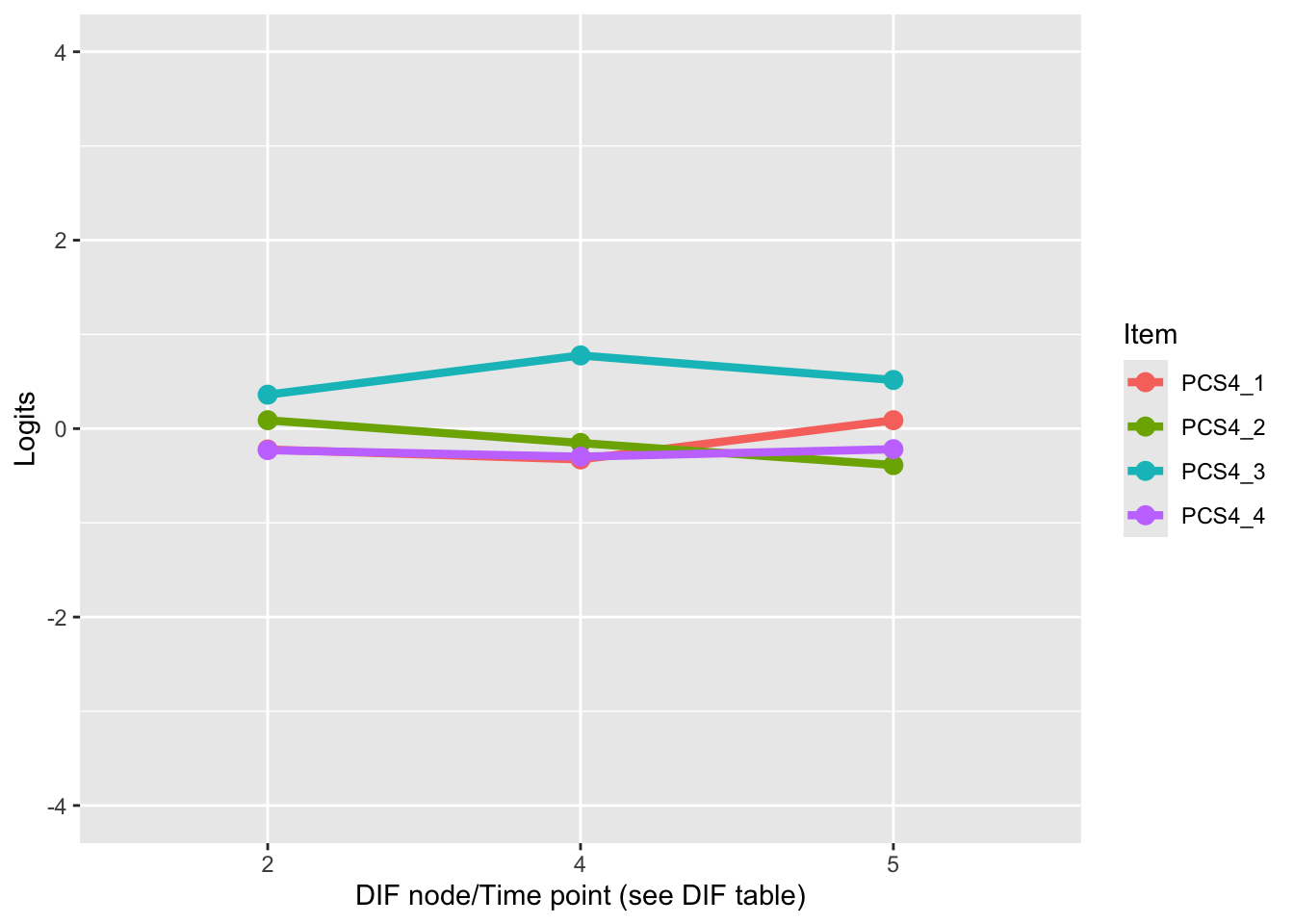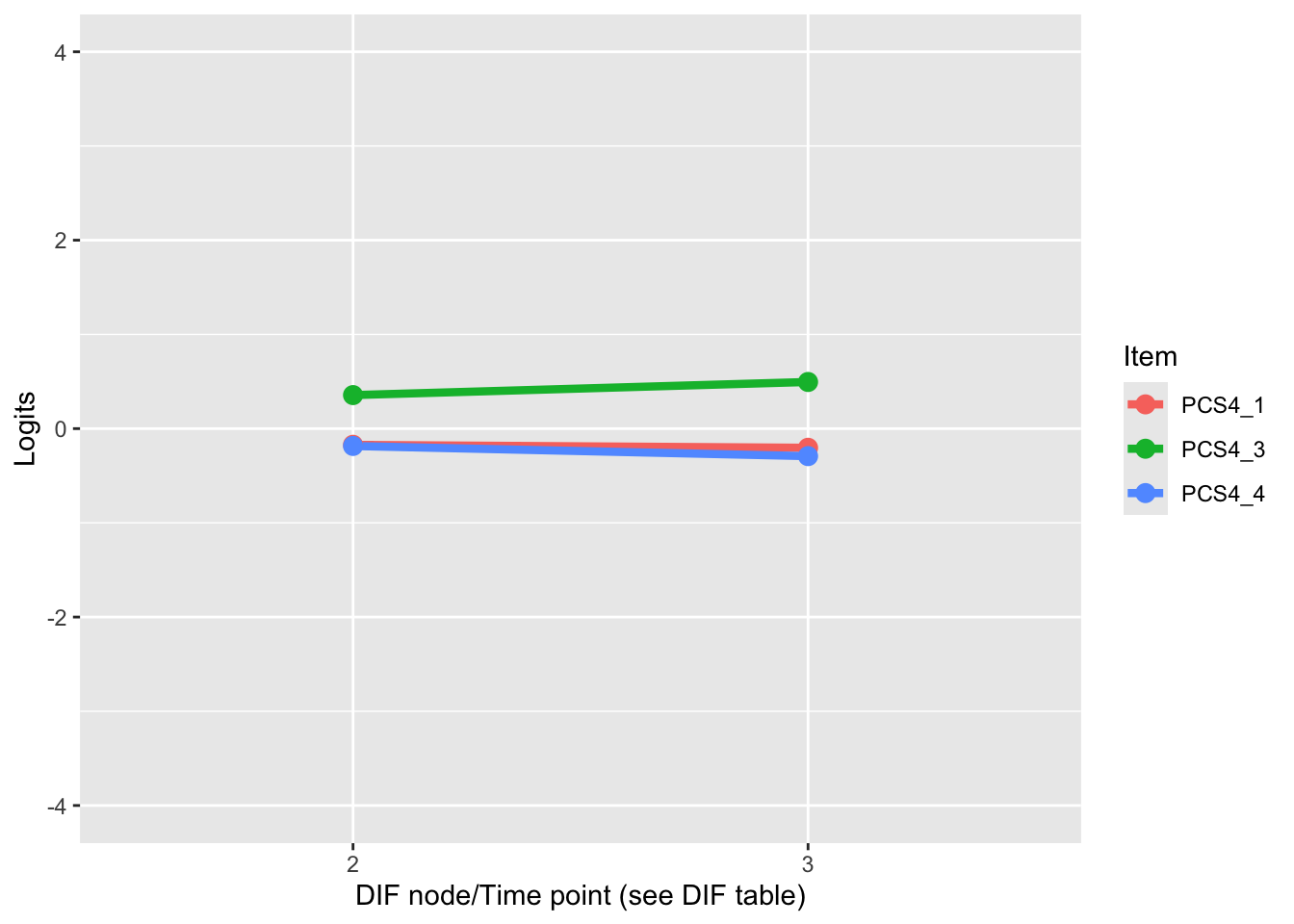Background
Since these items have 7 response categories we will use a stacked dataset to make sure we have enough responses in each response category.
Descriptives
0.9366864 of respondents have complete data (n = 1583). We will remove those with missing data
Code d <- d.all %>% select ( starts_with ( "PCS" ) ,time ,PID ) %>%
na.omit ( )
# subset and remove DIF variable(s) dif.time <- d $ time d $ time <- NULL # subset and remove ID variable PID <- d $ PID d $ PID <- NULL
We need to recode to make 0 the lowest response category.
Rasch analysis 1
The eRm package, which uses Conditional Maximum Likelihood (CML) estimation, will be used primarily. For this analysis, the Partial Credit Model will be used.
Since we have a large sample size (n > 1000), we’ll add bootstrapped item-restscore as a method for assessing item fit (Johansson, 2025).
itemnr
item
PCS4_1
Jag känner mig säker på min förmåga att hantera min psykiska ohälsa
PCS4_2
Jag har förmågan att hantera min psykiska ohälsa nu
PCS4_3
Jag kan på egen hand hantera min psykiska ohälsa
PCS4_4
Jag känner att jag kan ta mig an de svårigheter det innebär att hantera min psykiska ohälsa
Code
Item
InfitMSQ
Infit thresholds
OutfitMSQ
Outfit thresholds
Infit diff
Outfit diff
Relative location
PCS4_1
1.183
[0.928, 1.071]
1.163
[0.92, 1.078]
0.112
0.085
0.11
PCS4_2
0.674
[0.92, 1.077]
0.674
[0.922, 1.086]
0.246
0.248
0.08
PCS4_3
1.116
[0.927, 1.084]
1.114
[0.913, 1.107]
0.032
0.007
0.95
PCS4_4
1.038
[0.91, 1.084]
1.022
[0.908, 1.086]
no misfit
no misfit
0.02
Note:
Code
Code
Item
Observed value
Model expected value
Absolute difference
Adjusted p-value (BH)
Statistical significance level
Location
Relative location
PCS4_1
0.74
0.75
0.01
0.891
-0.18
0.11
PCS4_2
0.85
0.75
0.10
0.000
***
-0.21
0.08
PCS4_3
0.73
0.75
0.02
0.540
0.66
0.95
PCS4_4
0.77
0.75
0.02
0.255
-0.27
0.02
Code
Item
Item-restscore result
% of iterations
Conditional MSQ infit
Relative average item location
PCS4_2
overfit
100.0
0.67
0.08
PCS4_4
overfit
6.4
1.04
0.02
Note:
Code
PCA of Rasch model residuals
Eigenvalues
Proportion of variance
1.47
42.2%
1.34
35.2%
1.18
22.5%
0.00
0.1%
Code
PCS4_1
PCS4_2
PCS4_3
PCS4_4
PCS4_1
PCS4_2
-0.2
PCS4_3
-0.44
-0.2
PCS4_4
-0.36
-0.22
-0.35
Note:
Code mirt ( d , model= 1 , itemtype= 'Rasch' , verbose = FALSE ) %>% plot ( type= "trace" , as.table = TRUE ,
theta_lim = c ( - 6 ,6 ) )
Code # increase fig-height above as needed, if you have many items RItargeting ( d )
Code
Item
2
4
5
Mean location
StDev
MaxDiff
PCS4_1
-0.222
-0.327
0.089
-0.153
0.216
0.416
PCS4_2
0.089
-0.152
-0.387
-0.150
0.238
0.476
PCS4_3
0.360
0.777
0.516
0.551
0.211
0.417
PCS4_4
-0.228
-0.298
-0.218
-0.248
0.044
0.080
Code
Code
Item Var gamma se pvalue padj.BH sig lower upper
1 PCS4_1 dif.time -0.1092 0.0368 0.0030 0.0120 * -0.1814 -0.0371
2 PCS4_2 dif.time 0.0495 0.0418 0.2365 0.9460 -0.0325 0.1315
3 PCS4_3 dif.time 0.1212 0.0352 0.0006 0.0023 ** 0.0522 0.1901
4 PCS4_4 dif.time -0.0112 0.0375 0.7660 1.0000 -0.0847 0.0624
Response categories are surprisingly well-behaved, considering the lack of labels.
DIF over time is not problematic.
Item 2 has low fit and problematic residual correlations. This is not surprising considering its very general content regarding the latent construct.
PCS4_2 “Jag har förmågan att hantera min psykiska ohälsa nu”
We’ll remove item 2.
Rasch analysis 2
itemnr
item
PCS4_1
Jag känner mig säker på min förmåga att hantera min psykiska ohälsa
PCS4_3
Jag kan på egen hand hantera min psykiska ohälsa
PCS4_4
Jag känner att jag kan ta mig an de svårigheter det innebär att hantera min psykiska ohälsa
Code
Item
InfitMSQ
Infit thresholds
OutfitMSQ
Outfit thresholds
Infit diff
Outfit diff
Relative location
PCS4_1
1.06
[0.931, 1.065]
1.043
[0.926, 1.067]
no misfit
no misfit
0.10
PCS4_3
1.009
[0.922, 1.075]
1.008
[0.919, 1.076]
no misfit
no misfit
0.83
PCS4_4
0.926
[0.932, 1.069]
0.909
[0.931, 1.078]
0.006
0.022
0.00
Note:
Code
Code
Item
Observed value
Model expected value
Absolute difference
Adjusted p-value (BH)
Statistical significance level
Location
Relative location
PCS4_1
0.71
0.69
0.02
0.316
-0.21
0.10
PCS4_3
0.71
0.69
0.02
0.316
0.52
0.83
PCS4_4
0.74
0.69
0.05
0.003
**
-0.31
0.00
Code
Item
Item-restscore result
% of iterations
Conditional MSQ infit
Relative average item location
PCS4_4
overfit
34
0.93
0
Note:
Code
PCA of Rasch model residuals
Eigenvalues
Proportion of variance
1.56
54.4%
1.44
45.4%
0.00
0.1%
Code
PCS4_1
PCS4_3
PCS4_4
PCS4_1
PCS4_3
-0.49
PCS4_4
-0.41
-0.4
Note:
Code mirt ( d , model= 1 , itemtype= 'Rasch' , verbose = FALSE ) %>% plot ( type= "trace" , as.table = TRUE ,
theta_lim = c ( - 6 ,6 ) )
Code # increase fig-height above as needed, if you have many items RItargeting ( d )
Code
Item
2
3
Mean location
StDev
MaxDiff
PCS4_1
-0.172
-0.203
-0.188
0.022
0.032
PCS4_3
0.356
0.495
0.425
0.099
0.139
PCS4_4
-0.184
-0.292
-0.238
0.076
0.108
Code
Code
Item Var gamma se pvalue padj.BH sig lower upper
1 PCS4_1 dif.time -0.1232 0.0357 0.0006 0.0017 ** -0.1932 -0.0531
2 PCS4_3 dif.time 0.1529 0.0347 0.0000 0.0000 *** 0.0850 0.2208
3 PCS4_4 dif.time 0.0037 0.0379 0.9230 1.0000 -0.0706 0.0780
Reliability
Code RItif ( d , samplePSI = TRUE )
Relatively small distances between thresholds 2 and 3.
Item 4 is overdiscriminating slighly (low fit and high observed value in item-restscore). Bootstrapped item-restscore indicates low levels of issues as well. No problematic residual correlations. PSI is 0.83 with item 4 included.
PCS4_4 “Jag känner att jag kan ta mig an de svårigheter det innebär att hantera min psykiska ohälsa”
Item parameters
Code
Ordinal sum score
Logit score
Logit std.error
0
-4.924
0.723
1
-3.583
0.863
2
-2.873
0.780
3
-2.385
0.694
4
-2.001
0.637
5
-1.667
0.605
6
-1.351
0.592
7
-1.031
0.593
8
-0.690
0.604
9
-0.309
0.621
10
0.110
0.641
11
0.544
0.662
12
0.981
0.686
13
1.439
0.719
14
1.953
0.769
15
2.580
0.841
16
3.385
0.941
17
4.384
1.014
18
5.884
0.796
Latent score
Code
Code
Min. 1st Qu. Median Mean 3rd Qu. Max.
-4.9233 -1.3505 -0.3089 -0.3125 0.9814 5.8843
Code






















